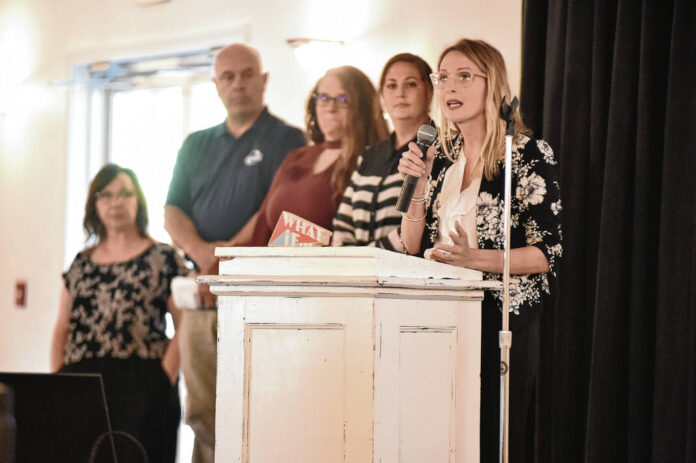
Stacy Findley of the Leadership Jackson County social concerns project team speaks during project presentations May 19 at Pewter Hall in Brownstown. Other team members are, from left, Dee Smith, Brad Marlow, Rachael Carpenter and Lori Scrivnor.
Zach Spicer | The Tribune
Meeting with Seymour Mayor Matt Nicholson, a Leadership Jackson County project team learned of a change in the way registered voters cast their ballots.
Starting with the May 3 primary election, county residents had to go to one of seven sites to vote.
The switch to vote centers offered flexibility and convenience to voters by allowing them to cast a ballot at any county location of their choosing on Election Day.
There were three sites in Seymour — Jackson County Learning Center, Fraternal Order of Police Donald M. Winn Lodge 108 and Calvary Baptist Church — along with ones at the enclosed shelter house at Brownstown Park, First Baptist Church of Crothersville, Freetown Community Center and Medora Christian Church.
Plus, for the 30-day period before the election, the learning center and FOP in Seymour and shelter house in Brownstown were open weekdays and Saturdays to give registered voters a chance to fill out their ballots early.
The social concerns project team of Rachael Carpenter, Stacy Findley, Brad Marlow, Lori Scrivnor and Dee Smith created one flier listing the seven polling sites and another flier with a QR code for the website indianavoters.in.gov, where people can check to see if they are registered to vote, determine where they can vote and see a list of candidates.
Smith said the fliers were distributed in person and via email locally, and they also were posted on social media.
Scrivnor said the goal was to help voters and remove any barriers of them casting their votes.
“Our project was really aimed at reducing any other confusion or anything about knowing where they need to be,” she said. “Especially local elections really impact our community, and not voting is kind of giving up your voice in those decisions. Voting in general is a way to participate in the community, meet your neighbors and cast your vote.”
According to the most recent census, Carpenter said of the county’s population of nearly 46,000, those age 18 or older potentially eligible to vote is around 35,000.
Obtaining historical voting data from recent years, though, the project team learned turnout has been really low.
In this year’s primary election, only 16% of registered voters voted. That was below the 29% who turned out to vote in the 2018 primary.
“Even with fewer sites, the county has worked to make voting as accessible as possible,” Carpenter said.
Moving forward, including the Nov. 8 general election, Findley said the group will continue to spread the information about the new voting centers and the state website so people know about the change in the voting process.
